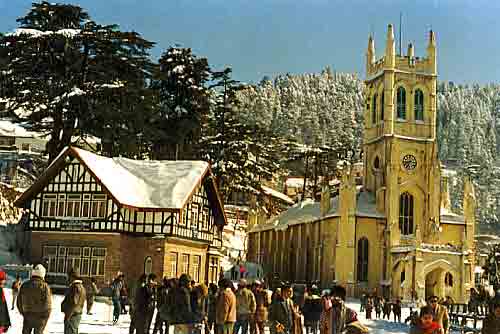|
|
The `Norbulingka Institute' is particularly concered to make
excellent works of art and preserved Tibetan culture which is
threa-tned today with destruction and become a minority on its
home-land'remarked Mr. Gyaltsen Tsering who is looking after the
public Relations & Project work of the institution. In fact,
Tibetan had struggled hard to preserve their culture heritage,
identity, religion and institutions inspite of uprooting long back
from their own land-Tibet. |
Close to the Gyato Monastery, where 14 years old 17th
Karmapa Ugyen Trinely Dorje has been staying after escaping from a
monastery at Lhasa in Tibet, an ideal place for experiencing
the
highs of Tibetan culture Norbulingka Institue is situated at Sidhpur
near Dharmsala town. Introduction of Tibetan cultural traits can be
seen in different religious and cultural institution in the different
towns of Himachal Pardesh but Norbulingka institute preserving rich
Tibetan culture is one of them with unique type of distinguishing
features. This institute is registered trust functioning under the
Chairmanship of spiritual leader His Holiness Dalai Lama. It is purely
built according to traditional Tibetan style and placed amidst the
surroundings of beautiful gardens and green fields of Kangra hills at
the backdrop of majestic Dhauladhar mountains of the outer Himalayan
range.
Norbulingka institute's visual focal point is its main temple where
1,173 images of Buddha decorate the 44 foot high temple hall. The
temple is the master spiritual centre which took more than a year for
its completion. The gilded 14 foot copper statue of Buddha Shakyamuni
is the largest of its kind ever made in exile. A subsequent six and
eight foot statue of Guhyasamaja and Kalchakra images respectively are
works that have also never before been attempted in exile. The
statues are magnificently curved showing elaborate figure composition
with Buddha occupying the chief position.
Other worth seen paintings dipict twelve deeds of Buddha, fourteen
incarnations of the Dalai Lama temple. Its ground plan based on the
proportions of Avalokiteshvara, the pattern god and Bodhisattva of
compassion, which invoked against the danger's
that threaten mankind. "Avalokiteshvara'
is represented in many forms and the most common being the images with
four arms" told an old monk sitting in the temple. The skilled masters
provide training to the Tibetan students in literary studies, variety
of crafts skill and thus promotes Tibetan traditional art told Mr.
Gyaltsen.
The skills preserved and passed on of high quality art objects at
Norbulingka institute include statue making, thangka paintings,
appliqué needlework, woodcarving, carpentry and metal work crafts. `thangka
paintings' known as `patta' in sanskrit are traditional Buddhist
scroll paintings drawn on cloth and canvas and are prepared with the
use of traditional vegetable and mineral colour, told a middle aged
Lamba artist busy with his painting. These thangka paintings are of
sacred and ceremonial subjects. They are hung up in temples & can be
rolled up to be carried while traveling. The work done in different
art sections, itself elaborate that the efforts in preserving Tibetan
heritage and passing it on to the new generation of young artists is
true and encouraging.
The proportional grids relevant to each deity in the painting and
preparation of statue is trained to the students by the master of
paintings Temba chopel and statue maker Pemba Dorje, who learnt this
art in Tibet. Their efforts in the art field increases appreciation
and awareness of the excellence of Tibetan art among the domestic and
foreign art lovers. The main object and deliberate efforts of the
institution is to pass on the unique sense of ethical values
associated with this sacred art to the young artists.
The statue and sculpture work indebted to those sources from which
they drew their religion and culture. The statues are made of
different sizes, cast in the traditional lost wax method, to colossal
images assembled from hand beaten copper plates. The images describe
the detail of weapons and ornaments, the number of heads and arms as
well as symbols and the position in which the divinity sits. Mention
may be made of Tibetan metal work with wide range of domestic wares
and jewellary which are adorned with bends and mixing of metals found
in the favourite device of the kinnouri &
Spitian smiths. the techniques of repouses, the lost wax method and
sand costing is used in the craft manship of metal work.
The appliqué artists at Norblingka do the finest work in preparing
silk thangkas which become popular in 19th century. These are
constructed of many hand cut pieces of silk and brocade as long as the
size of fifteen story high building . Choe Phuntsok master in wood
carving comments that they are maintaining tradition of wood carving
which have virtually become non existent in their homeland. The carving
of wood with tools they make themselves with elegant detail and
delicate perfection back us to the 7th century and remind that ancient
art tradition. the completed carved objects are made smooth and shiny
in the time honored manner, painted in the healthy Tibetan traditional
colours of further embellished with gold leaf.
Richness and diversity of Tibetan costumes is introduced to the world
by the Losel team of monksin the losel Doll museum of the institute.
Attractively skilled and minutely produced more than 160 dolls in
different characters in the Losel Doll museum is another site of
admiration in the Norbulingka institute.
The indigenous knowledge of art, architecture and culture traits
flowed from north-east since 7th century in India is well observed in
this institute's entirety.
Rockcut Temple Masroor |

